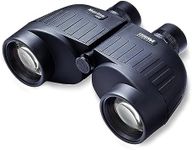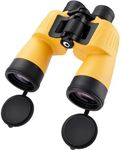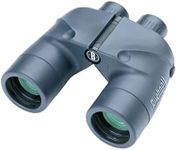Buying Guide for the Best Marine Binoculars
Choosing the right marine binoculars is essential for anyone who spends time on the water, whether for boating, sailing, or fishing. Marine binoculars are designed to withstand harsh conditions and provide clear, stable views even in rough seas. When selecting marine binoculars, it's important to consider several key specifications to ensure they meet your needs and enhance your experience on the water.MagnificationMagnification refers to how much closer the binoculars can make objects appear. For marine use, a magnification of 7x is generally recommended because it provides a good balance between image stability and detail. Higher magnifications, like 10x or more, can make the image shaky, especially on a moving boat. If you need to see distant objects clearly but also want a stable view, stick to 7x magnification.
Objective Lens DiameterThe objective lens diameter is the size of the front lenses, measured in millimeters. This spec is important because it determines how much light the binoculars can gather, affecting image brightness and clarity. For marine binoculars, a diameter of 50mm is ideal as it provides a bright image in low-light conditions, such as dawn or dusk. If you often find yourself boating in low-light environments, opt for binoculars with larger objective lenses.
Waterproof and FogproofWaterproof and fogproof features are crucial for marine binoculars to ensure they can withstand exposure to water and humidity. Waterproof binoculars are sealed to prevent water from entering, while fogproof binoculars are filled with nitrogen or argon gas to prevent internal fogging. If you plan to use your binoculars in wet conditions or varying temperatures, make sure they are both waterproof and fogproof to maintain clear visibility.
Field of ViewField of view is the width of the area you can see through the binoculars, usually measured in feet at 1,000 yards. A wider field of view allows you to see more of the horizon, which is beneficial for scanning large areas of water. For marine use, a field of view of around 350 feet at 1,000 yards is recommended. If you need to quickly spot objects or navigate, choose binoculars with a wider field of view.
Image StabilizationImage stabilization technology helps reduce the shakiness of the image caused by the movement of the boat. This feature is particularly useful in rough seas or when using higher magnification binoculars. If you often find yourself in choppy waters or need a steady view, consider binoculars with image stabilization to enhance your viewing experience.
Compass and RangefinderSome marine binoculars come with built-in compasses and rangefinders, which can be useful for navigation and measuring distances. A compass helps you determine direction, while a rangefinder can estimate the distance to an object. If navigation and distance measurement are important for your activities, look for binoculars with these integrated features.
Durability and Build QualityDurability and build quality are important to ensure your binoculars can withstand the harsh marine environment. Look for binoculars made from robust materials like rubber-armored coatings that provide a good grip and protect against impacts. If you need binoculars that can endure rough handling and exposure to saltwater, prioritize those with high durability and solid construction.













